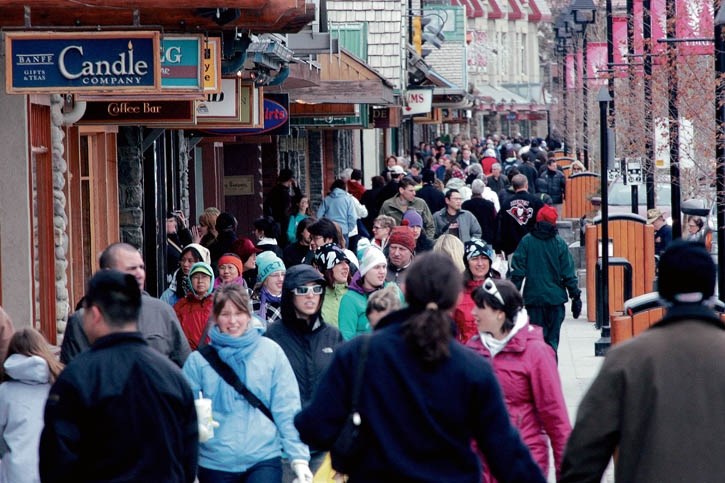BANFF – Geopolitical tensions between the Chinese and Canadian governments has pushed Banff’s leading tourism organization to rethink its marketing strategy.
Leslie Bruce, president and CEO for Banff Lake Louise Tourism, said her organization intends to diversify its marketing strategy in the wake of the geopolitical tensions caused by the arrest of Meng Wanzhou, the chief financial officer of Huawei, China’s leading telecoms company and the world’s third largest smart phone manufacturer.
“We continue to monitor the situation in China,” said Bruce, during her organization’s annual general meeting on April 23. “We’re not giving up on that market, but we’re certainly not as bullish about the growth opportunity there.”
Wanzhou was arrested in Vancouver on a U.S. arrest warrant on Dec. 1, 2018 and now faces extradition to the United States on charges that she allegedly engaged in bank and wire fraud in violation of American sanctions against Iran. She has denied any wrongdoing.
Her arrest severely strained Canada’s relations with the Chinese government, which has demanded her immediate release and arrested two Canadians it claims are a threat to China’s national security.
Bruce said the geopolitical fallout has not been felt directly in Banff, however her counterparts in Toronto and Vancouver have told her they’ve noticed an impact.
“Our operators that work with our Chinese travel trade have definitely seen some softness, but we’re not seeing it at the same scale as some of the larger centres,” said Bruce.
To diversify its marketing strategy, she said BLLT has begun to redirect its marketing efforts towards visitors from Australia, South Korea and Mexico. Her organization also has plans to target visitors from France.
“We’re really taking a harder look at what’s working there and looking at ways to augment things that are working in terms of placing that investment.”
While BLLT looks to other destinations to grow visitation, Destination Canada downplayed the impact the geopolitical fallout has had on Canada’s tourism industry.
“Destination Canada’s marketing efforts in China remain business as usual,” wrote Denyse Waissbluth, a spokesperson for the organization. “China continues to be our third largest inbound market and strategically important to Canada.”
She said in 2018, Canada welcomed 737,000 visitors from China, a record-breaking number that was up six per cent over 2017.
In February, two months after the CEO’s arrest, she said visitor numbers continued to grow, reaching 98,245 travellers, up 1.2 per cent year-over-year – another record breaking number.
Despite the growth in visitation, Waissbluth declined to comment on the geopolitical tension.
“As the national tourism marketing agency, we do not speculate on policy or geopolitical issues, however we continually monitor the impact of our marketing efforts across all of our markets,” she said.
Angela Anderson, senior manager for media and communications for BLLT, sent a follow up email to address the different approaches between the two tourism organizations.
“It seemed there may be a perception that we have shifted marketing away from China and that is not true,” wrote Anderson in the email.
“To clarify our position, China continues to be an important inbound market to tourism in Banff and Lake Louise. It is currently one of our key markets and one of the fastest growing markets in our business plan. Other grow markets include Canada, U.S., Mexico and the U.K.”
She said China continues to be a vital market for Alberta’s tourism economy, and in 2016 accounted for 135,000 visitors, many of whom visit Banff and Lake Louise.
She said BLLT also has ongoing marketing activities in China, including a Chinese website, social media channels and a business development manager for Asia.
“We are definitely monitoring and evaluating all of our market efforts constantly and we feel it’s important to have a diverse portfolio of markets to look to attracting visitors.”
While it’s too soon to say if the geopolitical tensions will hurt local tourism operators in the long run, the average room occupancy in Banff was 71.7 per cent in 2018, up from 68 per cent three years ago, according to BLLT’s annual report.
“Driving this is an additional 100,000 room nights generated in winter and shoulder seasons,” said David Roberts, chair of BLLT.
Despite strong room occupancy rates year-over-year, the organization still missed a key target for room night growth in the shoulder seasons.
In 2018, the organization set a target for 19,446 room nights from October to May, however when the final tally came in the actual number was 14,829.
“We’re happy to see this number increased from 2017, but we still landed shy of where we wanted to be,” said Roberts. “Knowing this, we will review the data and see how we can do better in 2019.”
In a bit of good news, hotel occupancy exceeded 50 per cent in November for the first time and the organization’s marketing efforts lead to more then 1.8 million leads for its members, more than three times its target from 2016.




